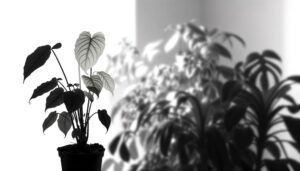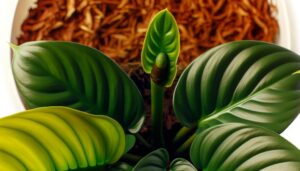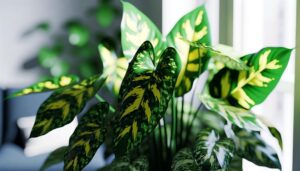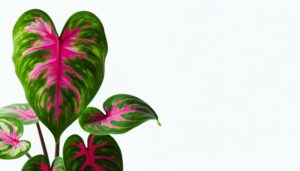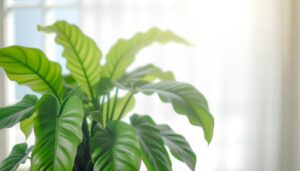What Is Philodendron Selloum-Bipinnatifidum, Also Known as Split Leaf?
Philodendron selloum, also known as Philodendron bipinnatifidum or Split Leaf Philodendron, is a tropical plant originating from South America, including Brazil, Bolivia, Argentina, and Paraguay. It features glossy, deeply lobed leaves up to 1.5 meters long with a feathery, split appearance.
The plant thrives in humid environments with indirect, bright light and requires well-draining, nutrient-rich soil. With prominent aerial roots, it often grows epiphytically on other plants.
While it rarely flowers indoors, its inflorescence consists of a spadix surrounded by a spathe. By learning more, one can discover ideal care and propagation techniques.

Key Takeaways
- Philodendron selloum, also known as Split Leaf, is a tropical plant native to South America.
- It features glossy, deeply lobed leaves that can grow up to 1.5 meters long.
- The plant thrives in humid environments with indirect, bright light and well-draining soil.
- Philodendron selloum produces aerial roots for climbing and nutrient absorption.
- It is well-suited for indoor growth but rarely flowers indoors.
Plant Origins

Philodendron selloum, also known as Philodendron bipinnatifidum, originates from the tropical regions of South America, particularly Brazil, Bolivia, Argentina, and Paraguay.
This perennial species thrives in humid, forested environments where it benefits from the rich, well-draining soil and consistent moisture levels. Adapted to the understory of tropical forests, it exhibits a high tolerance for low light conditions, which mimics its native habitat's shaded canopy.
The plant's natural ecosystem provides the ideal conditions for its growth, including warm temperatures and high humidity. As an epiphytic and hemiepiphytic plant, Philodendron selloum often grows on other plants or trees, deriving support while not being parasitic.
Its native regions contribute to its robust growth characteristics and ability to adapt to various indoor environments.
Distinctive Features
Benefiting from its tropical origins, Philodendron selloum exhibits distinctive features such as deeply lobed, glossy green leaves that can grow up to 1.5 meters in length, providing a dramatic visual presence in both natural and indoor settings.
The leaves are pinnatifid, meaning they are divided into multiple lobes that extend almost to the central vein, giving a feathery appearance. This species also develops prominent aerial roots, which can assist in climbing and nutrient absorption.
The plant's robust trunk, which thickens with age, supports its substantial foliage. Additionally, Philodendron selloum produces an inflorescence consisting of a spadix surrounded by a spathe, although it rarely flowers indoors.
These features collectively contribute to its reputation as an impressive ornamental plant.
Ideal Growing Conditions
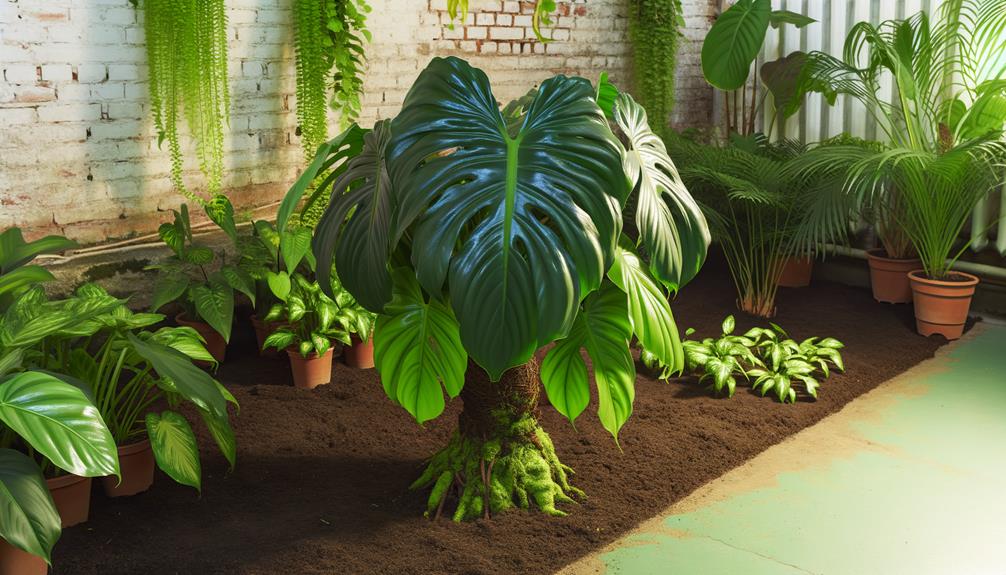
To thrive, Philodendron selloum requires a humid environment with temperatures ranging between 18-27°C (64-81°F) and indirect, bright light to mimic its native tropical habitat. Best humidity levels should be maintained between 60-80%, as this plant is indigenous to rainforests.
Soil composition is essential; a well-draining potting mix enriched with organic matter, such as peat moss or compost, is ideal. This prevents root rot while providing necessary nutrients. Additionally, providing a support structure can be advantageous since Philodendron selloum exhibits an epiphytic growth habit in its natural setting.
Ensuring good air circulation around the plant will also prevent fungal diseases. Placement in areas with filtered sunlight, like near north or east-facing windows, supports healthy foliage development.
Watering Needs
Philodendron selloum-bipinnatifidum, commonly known as the Tree Philodendron, requires consistent moisture levels to thrive, ideally maintaining soil that is evenly damp but not waterlogged.
Overwatering can lead to root rot and other fungal diseases, making it essential to guarantee proper drainage.
Monitoring the moisture content in the soil and adjusting watering frequency based on environmental conditions is vital for maintaining plant health.
Ideal Moisture Levels
Best moisture levels are crucial for the health of Philodendron bipinnatifidum, necessitating a balance between consistent hydration and well-draining soil conditions. This tropical species thrives in environments where the soil remains moist but not waterlogged. Ensuring ideal moisture involves regular watering while allowing the top inch of soil to dry out between waterings. Utilizing a well-aerated potting mix with components like perlite or orchid bark aids in maintaining appropriate hydration levels.
| Factor | Description |
|---|---|
| Soil Moisture | Keep soil consistently moist but not soggy. |
| Watering Frequency | Water when the top inch of soil is dry. |
| Potting Mix | Use well-draining mix with perlite or bark. |
This care regimen prevents root rot and supports lush, healthy foliage growth, ensuring the plant's well-being.
Avoid Overwatering Risks
Overwatering, a common issue in the care of Philodendron bipinnatifidum, can lead to harmful conditions such as root rot and fungal infections. To avoid these risks, it is crucial to grasp the plant's watering needs meticulously.
- Soil Moisture: Confirm the top inch of the soil is dry before the next watering. Consistently moist soil without waterlogging is ideal.
- Drainage: Use well-draining soil and pots with drainage holes to prevent water accumulation at the roots.
- Water Amount: Water thoroughly but infrequently, allowing excess water to drain out completely.
- Humidity: Sustain ambient humidity levels rather than overwatering; this tropical plant thrives in higher humidity without saturated soil.
Complying with these guidelines will encourage a healthy Philodendron bipinnatifidum.
Soil and Fertilization
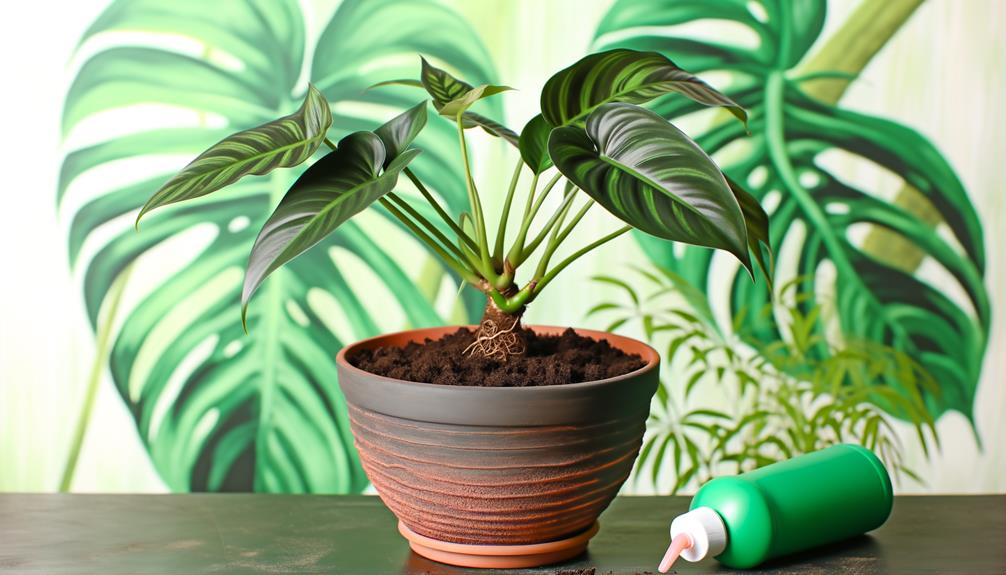
Philodendron selloum-bipinnatifidum flourishes in a well-draining, nutrient-rich soil mix made up of peat, perlite, and pine bark to guarantee ideal root aeration and moisture retention.
Fertilization should be done every two months during the growing season with a balanced, water-soluble fertilizer, like a 20-20-20 NPK formulation, to promote strong growth and foliage development.
Consistent monitoring of soil pH and nutrient levels will additionally improve the plant's overall health and resilience.
Ideal Soil Composition
A well-draining soil mixture rich in organic matter is essential for the best growth of Philodendron selloum (syn. Philodendron bipinnatifidum), ensuring adequate aeration and moisture retention. This tropical species thrives in soil that mimics its natural habitat, which is typically loose and nutrient-dense.
To achieve an optimum soil composition:
- Peat Moss: Enhances moisture retention and provides essential organic matter.
- Perlite: Improves aeration and drainage, preventing root rot.
- Compost: Supplies nutrients and beneficial microorganisms, promoting healthy growth.
- Pine Bark: Increases soil structure and adds organic content, aiding in moisture control.
These components, when properly balanced, create an ideal growing medium that supports the robust development and lush foliage characteristic of Philodendron selloum.
Fertilization Frequency
Consistent fertilization is crucial for the best growth and health of Philodendron selloum, requiring a balanced nutrient regimen tailored to its specific requirements. This species benefits from a regular feeding schedule, ideally every 4-6 weeks during the growing season, which spans from spring through early autumn.
Utilize a balanced, water-soluble fertilizer with an N-P-K (nitrogen, phosphorus, potassium) ratio of around 20-20-20. Dilute the fertilizer to half strength to prevent nutrient burn.
During the dormant winter months, reduce fertilization frequency to every 8-10 weeks or cease altogether, as growth slows significantly.
Monitoring soil pH, which should remain between 5.5 and 7.0, ensures the best nutrient uptake and overall plant health.
Light Requirements
Ideal growth of Philodendron selloum, also known as Thaumatophyllum bipinnatifidum, necessitates exposure to bright, indirect light conditions. This environment mimics their native tropical understory habitat, where direct sunlight is filtered through the canopy. Ensuring excellent light conditions for this species involves several key considerations:
- Light Intensity: Position the plant in an area receiving 10,000 to 20,000 lux.
- Duration: Aim for 12 to 14 hours of suitable light daily to sustain photosynthesis.
- Avoidance of Direct Sunlight: Direct exposure can scorch the foliage, causing brown leaf tips.
- Artificial Lighting: In low-light environments, supplement with fluorescent or LED grow lights to maintain necessary light levels.
These guidelines support healthy, robust growth and prevent etiolation and other light-related issues.
Common Issues
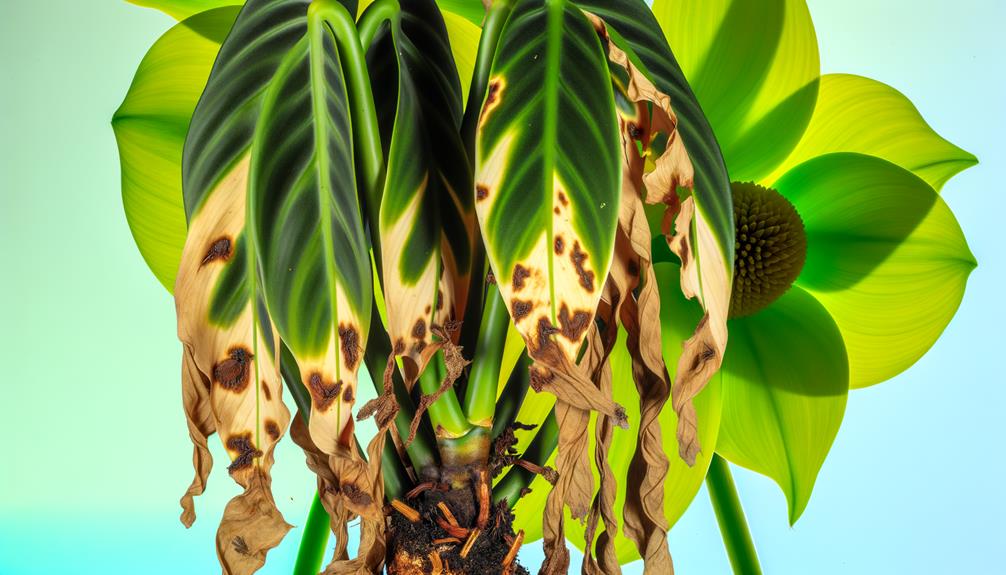
While providing ideal lighting is fundamental for Philodendron selloum, growers must also be vigilant about common issues that can affect this species.
Root rot, primarily caused by overwatering, manifests as yellowing leaves and mushy roots.
Pests like aphids (Aphidoidea), spider mites (Tetranychidae), and mealybugs (Pseudococcidae) can also plague the plant, leading to leaf discoloration and stunted growth.
Fungal infections, such as leaf spot caused by Xanthomonas campestris, appear as brown or black lesions on foliage.
Additionally, nutrient deficiencies, particularly nitrogen and magnesium, result in chlorosis, where leaves turn pale or yellow.
Ensuring appropriate watering practices, regular pest inspections, and balanced fertilization can mitigate these common issues and promote robust growth.
Propagation Tips
To propagate Philodendron selloum effectively, one should utilize stem cuttings with at least one node and aerial roots for best growth. Ensuring ideal propagation requires precise attention to detail and adherence to best practices.
The following steps outline a reliable method for successful propagation:
- Selection of Cutting: Choose a healthy stem with at least one node and visible aerial roots. This guarantees the cutting has necessary growth points.
- Preparation: Trim the cutting using sterilized shears to prevent infection. Remove any leaves near the base to avoid rot.
- Rooting Medium: Place the cutting in a well-draining medium such as perlite, sphagnum moss, or a mix of both to promote root development.
- Environmental Conditions: Maintain high humidity and indirect light to facilitate root growth and prevent desiccation.
Conclusion
Philodendron selloum-bipinnatifidum, resembling a lush protector of the rainforest, thrives under specific conditions similar to a well-coordinated symphony. The plant's intricate foliage, reminiscent of a conductor's careful composition, demands precise care. Proper light, balanced hydration, nutrient-rich soil, and diligent pest management are crucial.
When cultivated with scientific accuracy, this botanical wonder rewards with strong growth and luxuriant greenery, embodying nature's graceful harmony. Therefore, the split leaf becomes a tribute to the detailed interplay between environment and organism.


